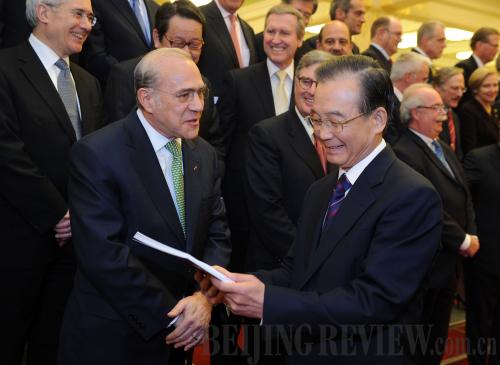|
 |
|
MEETING WITH DELEGATES: Chinese Premier Wen Jiabao (right front) receives a gift book from a guest when meeting with overseas participants attending the China Development Forum 2012 in Beijing on March 19, 2012 (XINHUA) |
China's economic growth has slowed down since last year. Weakening labor advantages, limited resources and deteriorating environment are adding to the factors restraining the country's economic growth, said Ma Jiantang, Commissioner of the National Bureau of Statistics.
Affected by the international economic environment, the Central Government's macro-control measures and other deeply rooted reasons, the growth rate of China's economy has gradually slowed since last year. Against this backdrop, how will China continue to maintain stable and relatively fast development?
"Basic factors promoting the rapid growth of China's economy—urbanization, industrialization, marketization and internationalization—have not changed in general," said Ma at the China Development Forum 2012 held in Beijing on March 17-19.
"But restraining factors have increased," said Ma. China should speed up transformation of its economic development model and economic restructuring.
"Urbanization will become a major feature for economic development in the future," said Liu He, Deputy Director of the Development Research Center of the State Council (DRC).
The urban population will account for about 60 percent of the total by 2020, and 65 percent by 2023, according to the DRC. A huge potential for investment and consumption amid the urbanization process will play an important role in driving China's economic growth, Liu said.
However, the proportion of the labor force to the total population decreased for the first time in 2011. According to China's sixth census, 100 employees or working-age people take care of 20 elderly people, and the ratio is growing rapidly. "The advantage of a cheap labor force supporting China's rapid economic growth is diminishing, which will have an impact on China's economic future," said Ma.
"There is only one way out—accelerating the transformations of the growth model and the economic structure," Ma said.
(Source: Shanghai Securities News)
| 